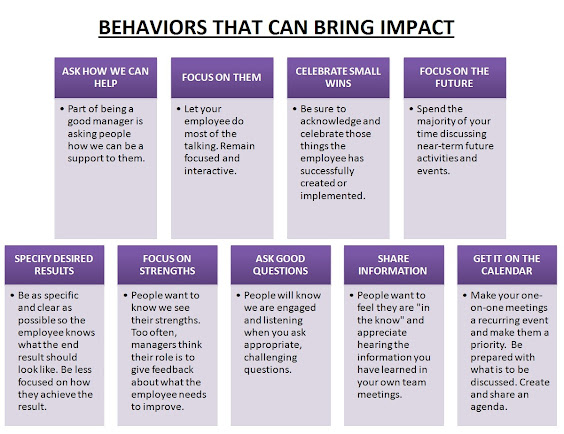The team meeting. A necessary evil, an exercise in wasting time, or our organization’s secret weapon? Sometimes we wonder why our one-on-one meetings tend to feel unfruitful. Stock questions might be effective once or twice. But when we ask them during every one-on-one, every week, and over time, the effectiveness of the questions erode. The person grows sick of answering the question. Or they do not think we really care to know the answer anymore. Before too long, they start looking at the clock, staring into the distance, and giving us those short, nondescript answers. To avoid this, we will want to avoid the routine questions we lean on. Some of them maybe:
01: “How’s it going?”
It seems like a solid way to break the ice and initiate a one-on-one meeting. Yet it’s unusual that we ever get an answer other than “Fine” or “Good” in response. While someone might truly be fine and good in reality (which is great!)…the conversation usually stops there. Anything personal we wanted to learn, any sense of rapport we wanted to create dies with the question. This is because, as a society, the question “How’s it going?” has become our default greeting to each other, so our answer to it has become just as automatic.
Alternate Perspective: If we are looking for a casual, open-ended way to kick off a one-on-one, ask “How’s life?”. It gives permission for someone to talk more personally about life — about what they did that weekend, how their family is doing, how their personal side project is coming along, how they’re managing their workload. “How’s life?” invites the other person to elaborate.
02: “What’s the latest on XXXXX ?”
It can be tempting to use our one-on-one session as
time to get caught up on what is going on. However, keep in mind that this
completely squanders the purpose of our one-on-one meeting, to begin with. A
one-on-one meeting isn’t a reporting session. It’s not an
accountability tool. A one-on-one meeting is our radar. It’s one
of the only ways we have to unearth what’s actually going on in our
team, and what an employee is thinking and feeling. Client
problems, unforeseen issues with the product, messy team dynamics, unspoken
personal frustration — this is only time we will get to hear that stuff.
This question “What’s the latest on X?” can be great if we are using it to segue into asking deeper questions. For example, perhaps we follow it up with, “What’s most frustrating about how X has been going so far?” Or, “Where do you feel you need more support in working on X?” Merely asking “What’s the latest on X?” falls flat if we use it singularly.
Alternate Perspective: Ask something specific about the project, instead of asking for a general project update. For example- “Can you tell me about what’s been most surprising about working on X so far?” If an employee has found something surprising, good chances that we will find it surprising too. A surprising insight is always useful for us to form an accurate picture of potential issues bubbling up within our team.
03: “How can I help you?”
The intention of this question is fantastic. We want to help and we want to figure out what we can be doing better. However, this question is the worst way to signal that. It makes the person receiving the question do all the hard work of having to come up with the answer. It’s also a very hard question to answer, especially on-the-spot and given that we are a person in a position of power. We are asking a person to critique us, “The Boss,” across all spectrums and come up with something actionable for us to do. If we do ask this question, answers tend to be, “Nothing I can think of right now,” something vague, or an answer that involves something that we are already doing.
Alternate Perspective: Suggest something that we can be doing to help. Then ask, “What do you think?” For example: “I was thinking I’m being too hands-on on this project. Should I back off and check-in with you only bi-weekly? What do you think?” By being targeted in what we suggest — and suggesting it ourselves — we make it easier for that person to share the exact ways in which we can support them. We help our people by suggesting what we think we can do to help, first.
04: “How can we improve?”
The problem with this vague question is they invite vague answers. We prompt the person to offer broad suppositions and knee-jerk assumptions, instead of exact details and practical examples. Ask an employee “How can we improve?” and they think, “Hmm, from a business development perspective? Marketing perspective? Leadership perspective? Where to even begin?”
Now, some employees we work with will be able to craft a distinct, rich answer from this question. But it is infrequent and they probably spent time thinking about the answer beforehand. For most employees who we ask this question to without any warning, we will receive a variant of “I think things are pretty good right now” about 90% of the time.
Team/ One-on-one Meetings
There
is broad consensus that the team/ one-on-one is one of, if not the, most
important meeting we can have. But what exactly can we accomplish through 1:1
meetings? Successful 1:1s aim to facilitate the following things:
a) Building a trusting relationship
b) Staying informed and aligned
c) Providing mutual feedback to help each
other grow
d) Addressing topics prone to getting lost in the shuffle (e.g., career development)
In conclusion, the questions do the heavy lifting. The questions determine the path to which our one-on-one meetings will take. Ask thoughtful, sincere questions, and there’s a higher likelihood our answers returned back will be thoughtful and sincere too.
Content Curated By:
Dr Shoury Kuttappa




Comments
Post a Comment